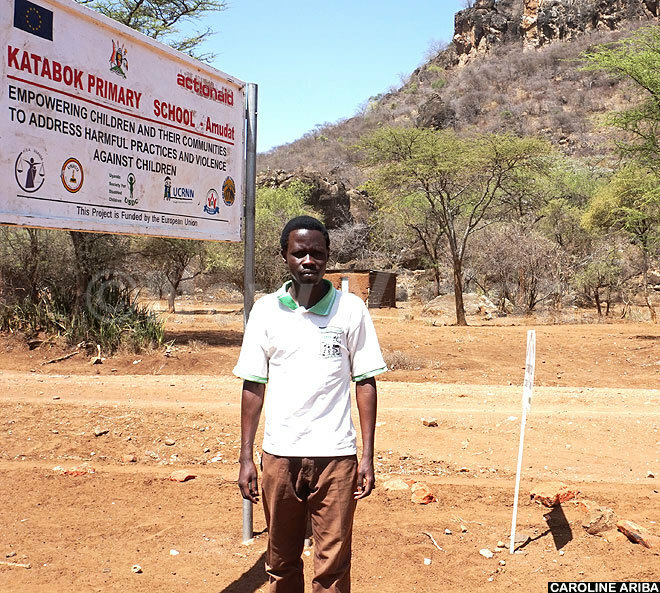The 'surgeons': The masterminds behind FGM
It is not what she says, but rather what she doesn’t. It is not even the emphasis with which she says it.
PIC: This woman claims she is no longer a cutter, but is it true? (Credit: Caroline Ariba)
FIGHTING FEMALE GENITAL MUTILATION: PART II
For Female Genital Mutilation (FGM) to happen, there is always a cutter. Also known as surgeons, cutters have mastered the game of cat-and-mouse with the authorities. Years after Uganda put in place a law criminalizing the ritual, FGM still rears its ugly head. Caroline Ariba recently had a chat with a cutter that claimed to have abandoned the practice. But has she?
INTRODUCTION
It is not what she says but rather what she doesn't. It is not even the emphasis with which she says it. It however is the way she stutters when asked eminent questions. There in her silence emerges the answer to my question: "Are you still cutting Ugandan girls?"
It is the way she goes cold when pressed to answer, the flicker in her eyes. The lines instantly forming in her face. The frustration glaring through her tiny frame tell it all. It isn't in her words, but in the mannerisms. This old lady is exuding deception, and something has got to give!
Like her true allegiance, her name remains a mystery.
Although she swears that since the coming of the law against Female Genital Mutilation she has not cut any girls, it seems hard to believe. "No, not me, maybe others," she instantly springs to her own defence. "In other villages maybe, not this village!"
Like the cleansers in our Part One of this series, she hails from Katabwok sub-county in Amudat district. And just like the cleansers again, her answers are rehearsed, but unlike the elders, she looks like she is about to take off when pressed. "Me, not me, not me… er… it is not here, for us we have refused FGM ever since the law was brought," she vehemently shakes her head.
It is almost believable until she is asked when the last time she circumcised a girl was.
"Er… two years ago… er… three years ago," she responds and silently goes mute. She knows she must have blundered as everyone goes silent. "We do not cut girls in this village, no!"
But two years ago practising FGM would still have been a crime, right?
'WE ARE POOR'
At this point she starts to turn her back away from the microphone. She knows something is not right and thinks it might be time to run. This meeting, also arranged by the United Nations Population Fund (UNFPA), should have included her fellow ‘former' cutters, but they had been delayed somewhere.
Asked where they were, she points at a random direction and it is obvious, she now thinks her friends could be arrested. She only stops after realizing the team only had questions and wanted to know why the practice continued.
"We are poor!" she exclaims, before going silent again.
She says that the loot they make from the FGM season is a whole lot to give up. She again stops herself, and rectifies her mistake; "but we have allowed to follow the law!"
Godfrey Kurong (pictured below), is an FGM monitor with a local organization called Vision.

According to him, there were cases of FGM in that area late last year. But he believes that the awareness of an existing law is there and the perpetuators know they could get arrested.
"At least now they cannot claim ignorance of FGM being a crime," he begins. "If they do it, it is done in the bushes far away, in the night more over."
Sadly, this place is far away, it is rocky; the roads mostly impassable, more so during the rainy season. It is inevitably a hard-to-reach area, and that right there allows for FGM to thrive.
WHAT WILL WORK?
In a joint United Nations Children's Education Fund (UNICEF) and UNFPA speech to commemorate the International Day of Zero Tolerance to FGM, UN Karamoja area coordinator Mohamed Satti said that to beat the 2030 deadline, the fight against FGM needed more commitment.
"To accelerate progress towards ending FGM by 2030, we need to strengthen the coordination and continuously engage communities to put in place mechanisms to ensure effective protection of women and girls," he said.
"Let us take girls to school. And to make sure that they stay in school. Llet us come up with a policy that ensures they have food at school."
As of today, Satti said that the UN had ensured there was food in the schools for at least thee months.
FACTS ABOUT FGM
- UNFPA defines FGM as the cutting or removal of the external female genitalia, for majorly cultural reasons
- It estimates that over 125 million girls and women in 29 countries in Africa and Middle East have gone through this gruesome act
- In high-prevalence countries, UN projections indicate that 15 million girls are at risk of being cut by 2020
- Although the national prevalence of FGM is at 1.4%, in the communities where it is practiced, it very high. In-fact, among the Pokot, it stands at 95% and among the Sabiny, Kadam and Tepeth tribes, it stands at 50%
- A 2011 Uganda Demographic Health Survey estimates that up to 490, 000 Ugandan women are suffering from the adverse effects of FGM
(In Part III of this series, we will look at the survivors and expert opinion on the way forward)
ALSO RELATED TO THIS STORY
The fight against FGM: Starting from the beginning